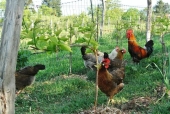
 6
6




 4
4




 8
8




 3
3




 2
2




 4
4




 2
2




 6
6




Life on a farm is a school of patience; you can't hurry the crops or make an ox in two days.
Henri Alain
 4
4




 5
5




William Bronson wrote:I have one mulberry that I'm keeping in check through aggressive pollarding.
I've taken to tying flexible young the branches down out of my way.
Often they break, yet remain half attached and heal in that position.
This puts the newest growth down at ankle height, which could be useful in a fodder system.
What if you cut a branch the same way you would for air layering, but did not wrap it in growth medium?
If it drys out, you have just made tree hay, with minimal infrastructure.
If it gets greener, good, it's probably gonna make for richer hay when you come back and harvest it.
I'm gonna try this.
Life on a farm is a school of patience; you can't hurry the crops or make an ox in two days.
Henri Alain

|
Your opinion of me doesn’t define who I am --tiny ad
The new purple deck of permaculture playing cards
https://www.kickstarter.com/projects/paulwheaton/garden-cards
|


